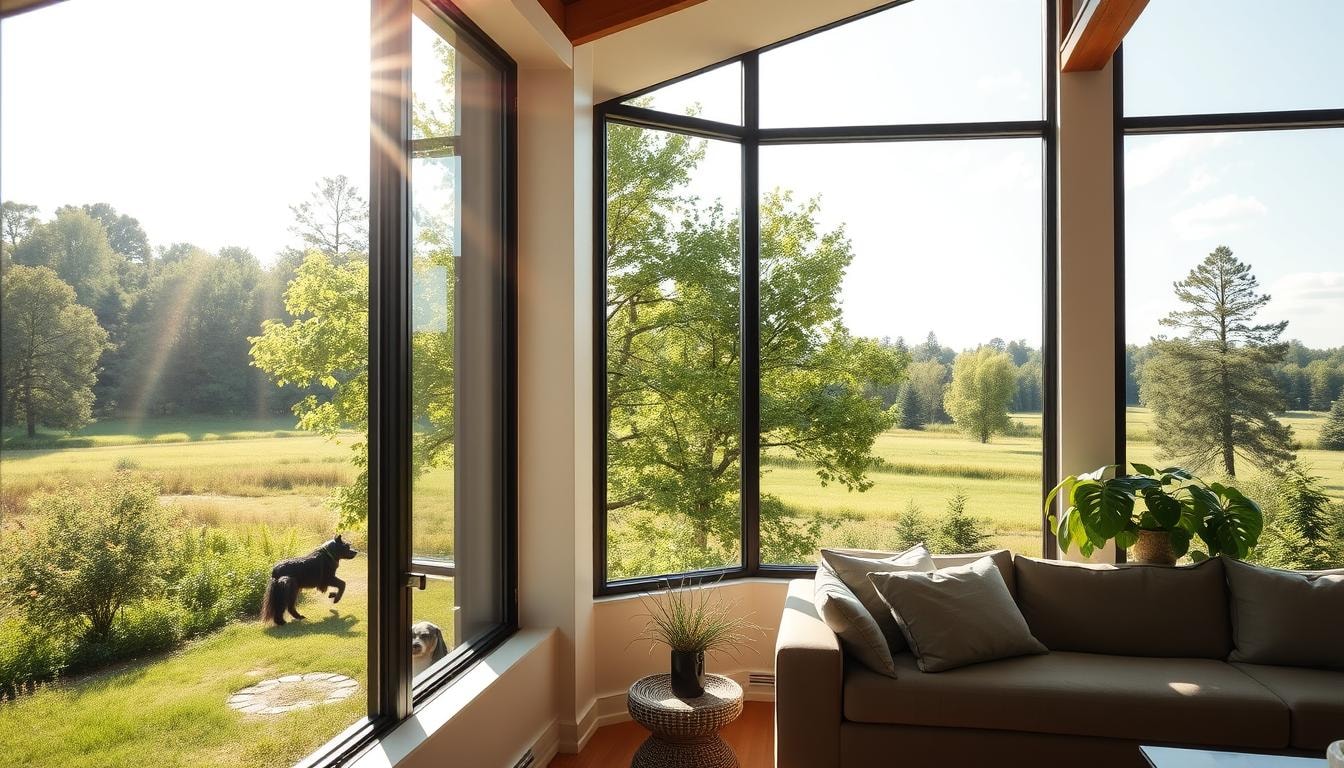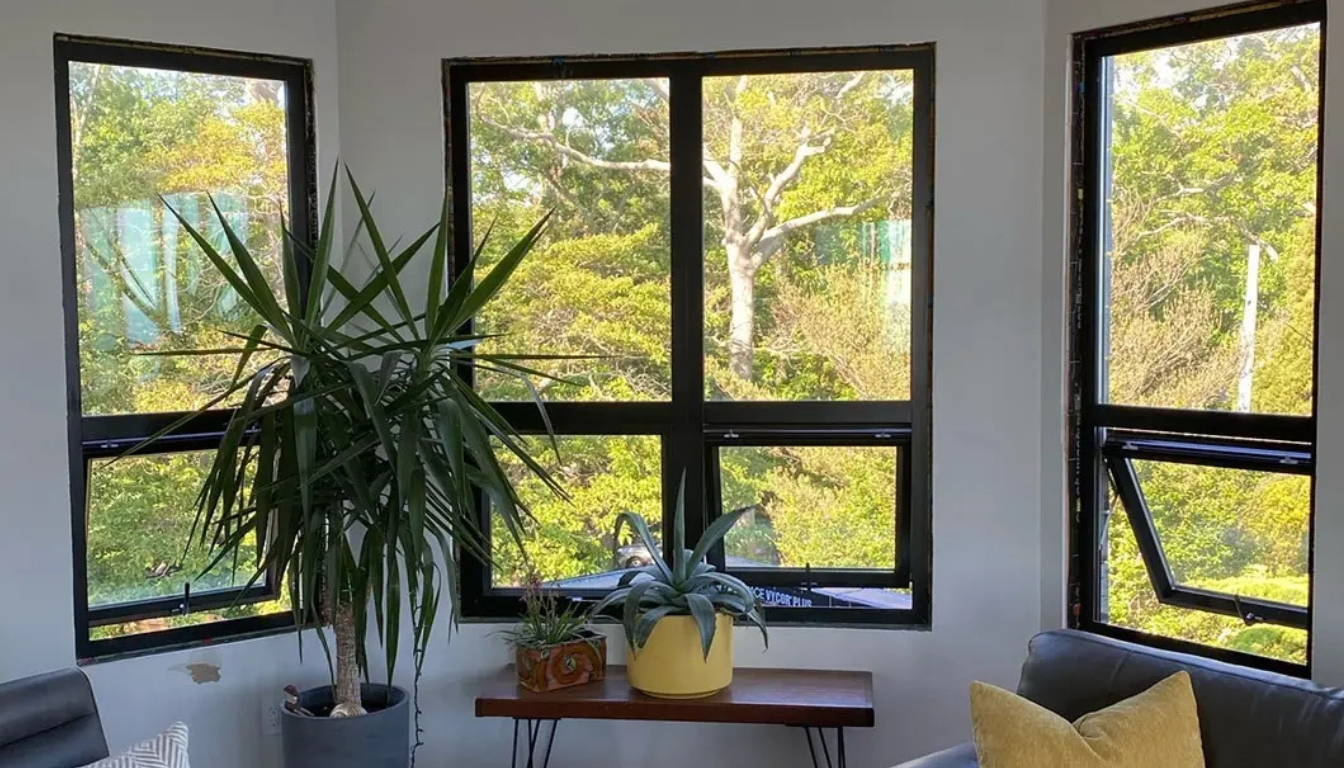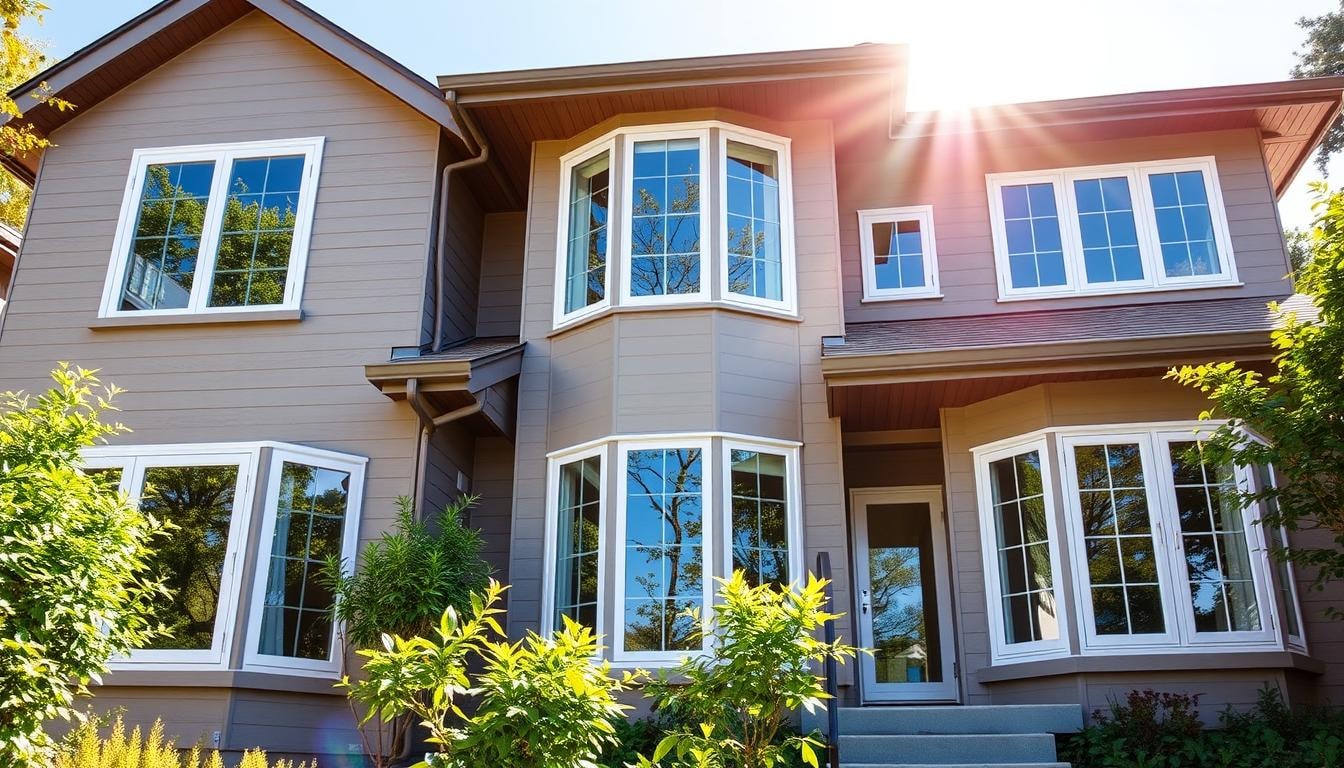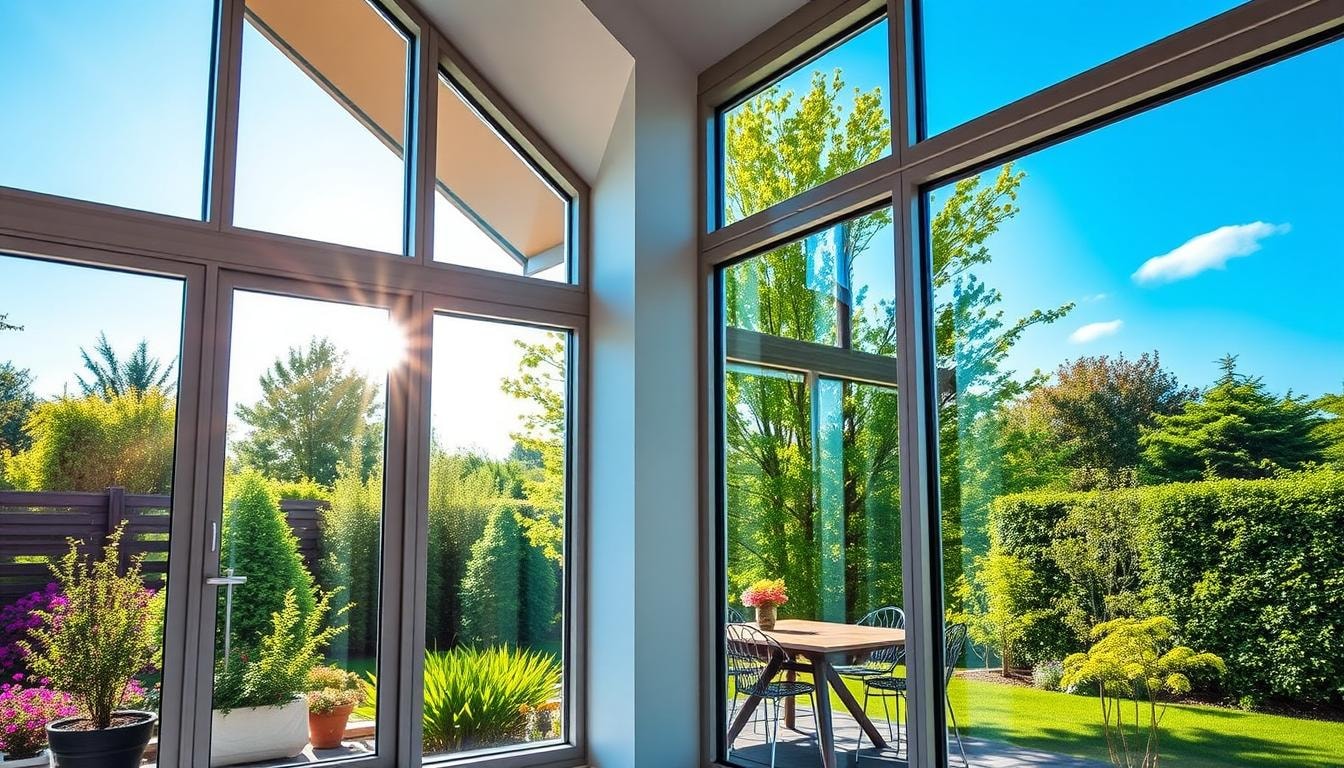
Cost for Energy Efficient Windows: Complete Price Guide
Energy-efficient windows are a big deal for homeowners. They cost between $150 and $4,000 per window, with an average of $1,337. These windows help keep your home warm in winter and cool in summer. They also make your heating and cooling systems work better.
These windows have special features like extra panes and special coatings. The size, type, and material of the windows also affect the price. Knowing these details helps you choose the right windows for your home.
Key Takeaways
- Energy-efficient windows typically range from $150 to $4,000 per window, with an average cost of $1,337.
- These windows can reduce a home’s heating and cooling energy loss by 25% to 30%, leading to lower utility bills and extended HVAC system lifespan.
- The cost of energy-efficient windows varies based on factors like size, type, frame material, and glazing options.
- Proper installation is essential for achieving optimal energy efficiency with new windows.
- Investing in energy-efficient windows can provide long-term cost savings and increase a home’s overall value.
Understanding Energy Efficient Windows Basics
Energy-efficient windows help keep your home warm in winter and cool in summer. They use special features like multiple glass panes and special coatings. These help your home use less energy.
What Makes a Window Energy Efficient
Several things make a window energy efficient. The type of glass, the frame material, and how well the window is sealed are important. These features help keep your home warm or cool, saving energy.
Benefits of Energy Efficient Windows
- Reduced energy consumption and lower utility bills
- Enhanced indoor comfort and temperature regulation
- Increased home value and curb appeal
- Improved soundproofing and noise reduction
- Reduced carbon footprint and environmental impact
Energy Star Certification Explained
The Energy Star certification is a government program. It shows windows that save a lot of energy. Replacing old windows with Energy Star-certified ones can save a lot of money.
Average Cost Range for Energy Efficient Windows
Homeowners can expect to pay $150 to $4,000 for each energy-efficient window. The average cost is $1,337 per window. For a whole-house replacement, costs range from $6,685 to $33,425.
The price varies based on window size, glass type, style, and frame material. Double-pane windows cost between $150 and $1,290. Triple-pane windows range from $400 to $3,540.
Energy-efficient windows can cut energy bills by 7% to 15%. This means saving $71 to $501 yearly. Over 10 years, savings could be $710 to $5,000.
When looking at energy-efficient windows, think about the return on investment (ROI). Homeowners might get back up to 78% of the cost when selling. They could also get up to $600 in federal tax credits for Energy Star-certified windows.
Factors Affecting Window Installation Costs
Installing energy-efficient windows can cost differently based on several factors. Knowing these can help you plan your budget better.
Window Size and Style Impact
The size of the window affects the cost. Bigger windows need more materials and work, which means higher prices. Also, special styles like bay or bow windows cost more than simple ones.
Labor and Installation Expenses
The work needed to install windows can change the labor costs. Using better glass, like double or triple-pane, might cost more upfront. But, it saves money on energy in the long run. Custom designs or tricky spots can also raise the price.
Geographic Location Considerations
Where you live can also change the cost of installing windows. Prices vary due to labor rates, material costs, and local rules. People in cities might pay more than those in the countryside.
Choosing energy-efficient windows and getting them installed by pros is smart. It ensures they’re done right, avoiding future problems and extra expenses. Knowing these factors helps you plan and budget well for your window project.
Cost for Energy Efficient Windows by Frame Material
Energy-efficient windows vary in cost based on the frame material. Homeowners have many choices, each with its own benefits and prices.
Vinyl windows are affordable, costing between $300 and $1,700 per window. They are a cost-effective and energy-saving option for those on a budget.
Wood frames are great for keeping warm in but need more care. Prices for wood-framed windows range from $300 to $2,000 per window. They are a more expensive choice.
Fiberglass windows are durable and save energy but cost more. They usually cost between $300 and $1,900 per window. They are a good choice for those looking for long-lasting windows.
Composite frames mix wood fibers and polymers. They offer a good balance of quality and price, costing between $400 and $1,900 per window.
Aluminum windows are sleek but pricier. They cost between $300 and $2,000 per window.

The final cost can also depend on window size, installation, and local prices. Getting quotes from different companies is wise to find the best deal.
Double-Pane vs Triple-Pane Window Costs
Homeowners often choose between double-pane and triple-pane windows. The choice depends on the benefits and costs. Double-pane windows cost between $150 and $1,290 each. Triple-pane windows cost more, from $1,800 to $3,000 each, which is 50% to 200% more than double-pane.
Double-Pane Window Pricing
Double-pane windows are a good mix of energy savings and cost. They keep the noise out and keep the warmth in. Prices vary based on style, size, and material, so you can find something that fits your budget.
Triple-Pane Window Investment
Triple-pane windows offer better insulation and noise control but cost more. They are 10-15% pricier than double-pane in Canada. Yet, they might save 2-3% on energy bills each year.
Energy Savings Comparison
The savings from triple-pane windows depend on your area and current windows. Natural Resources Canada says they can be 50% more efficient than double-pane. But, the extra cost might not always mean big savings on bills.
Window Styles and Their Price Points
Choosing the right window style can affect the cost. Bay windows are elegant and expensive, while double-hung windows are versatile and more affordable. Knowing the price range for each style helps you pick the best one for your budget and taste.
Bay windows offer wide views and cost between $1,030 and $8,300. Casement windows are great for air flow and cost $400 to $2,400. Double-hung windows are easy to clean and priced from $400 to $2,000. Picture windows give clear views and cost $300 to $2,000. Sliding windows are the cheapest, priced from $270 to $2,000.
The style you choose impacts your home’s look and function. Casement windows boost air flow. Picture windows make a beautiful view. Double-hung windows are classic and practical. The right window style balances cost and performance.
Energy Efficient Glass Options and Costs
Improving your windows’ energy efficiency starts with the glass. You can choose from low-emissivity (low-E) coatings, gas fills, and glazing types. Each option affects both how well your windows work and their cost.
Low-E Glass Technology
Low-E glass coatings reflect infrared and UV light. This helps keep heat in and out, improving insulation. Adding these coatings can cost $50 to $200 per window. But, the long-term energy savings are often worth it.
Gas Fill Options
Using gases like argon or krypton between window panes boosts insulation. Argon gas is cheaper, adding $10 to $40 per window. Krypton gas offers better insulation but costs $50 to $100 per window.
Glazing Choices
The number of glass panes affects a window’s energy efficiency and cost. Double-glazed windows have two panes and cost $150 to $1,290 each. Triple-glazed windows, with three panes, cost $400 to $3,540 per window. The extra pane in triple-glazed windows improves insulation but increases the initial cost.
Choosing the right low-E coatings, gas fills, and glazing balances energy efficiency and cost. These options can save money on heating and cooling over time.
Whole House Window Replacement Costs
Replacing all the windows in your house is a big project. The cost can change a lot. It depends on how many windows, what type, and the materials.
For homes with 5-6 windows, costs range from $5,855 to $7,026. Homes with 23-25 windows can cost $23,420 to $29,275. Buying all windows at once can save money because of bulk discounts and lower installation fees.
A survey found 47% of homeowners spent $500 to $3,000 on their window project. This shows how important it is to think about home renovation, energy upgrade, and window project budget when replacing all windows.
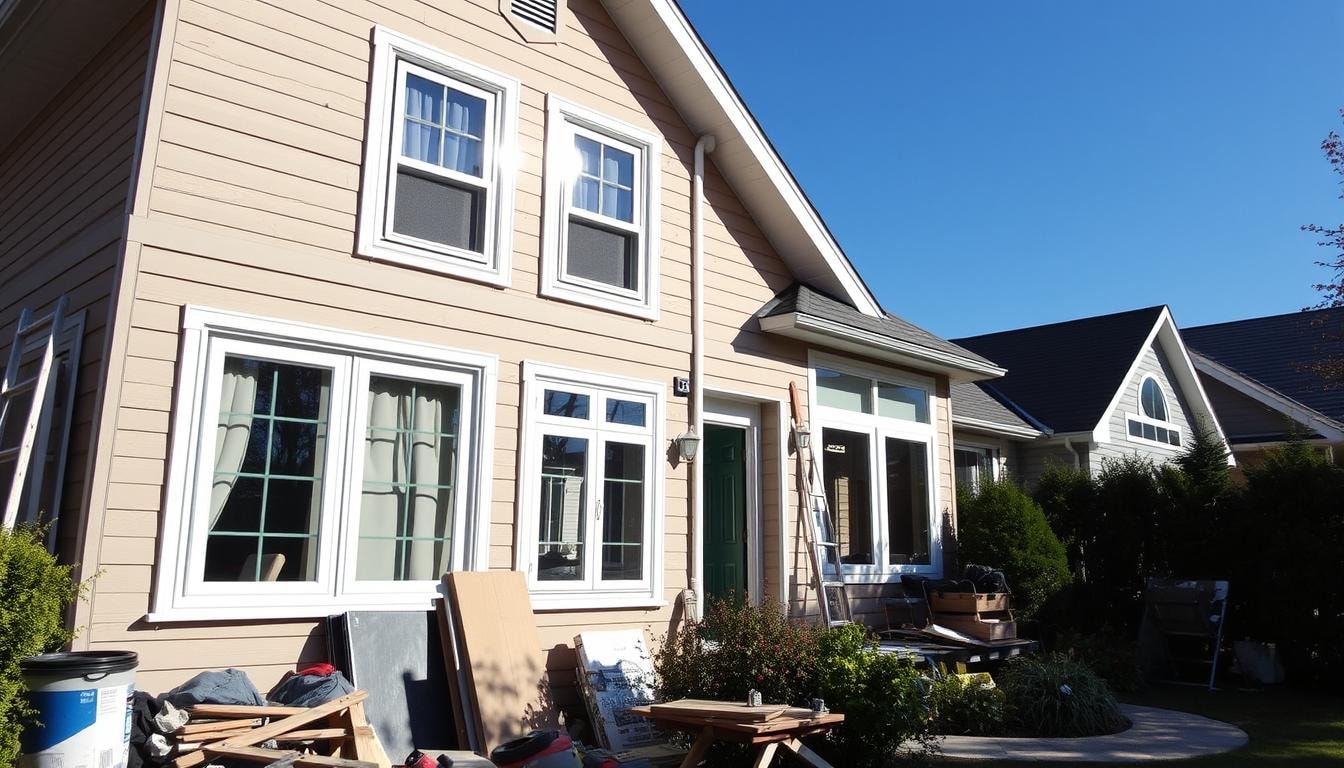
Looking to make your home more energy-efficient, improve its look, or update old windows? Knowing the costs of replacing all windows is key. Plan your window project budget well. This way, your home renovation and energy upgrade will be successful and affordable.
Return on Investment and Energy Savings
Energy-efficient windows are a smart choice for saving money. They can cut your utility bills by $101 to $583 each year. This is especially true if you replace old, single-pane windows.
The return on investment (ROI) depends on several things. These include your local climate, the condition of your current windows, and energy prices.
When figuring out the ROI, think about the savings, how much your home will be worth, and the upfront cost. For example, saving $300 a year for 10 years is a big deal. If your home’s value goes up by $2,000, you’ll get a 20% ROI. This number can grow if you get tax credits or rebates for making your home more energy-efficient.
Energy-efficient windows do more than save you money. They also make your home more valuable and attractive to buyers. People might pay up to $7,500 more for a house with new, energy-saving windows.
Even though energy-efficient windows cost more upfront, they’re worth it. They save you money over time and make your home more comfortable. With features like Low-E coatings and triple glazing, you’ll see big utility bill reduction, home value increase, and long-term savings.
Available Tax Credits and Rebates
Getting energy-efficient windows can cost a lot. But, there are many incentives and rebates to help. Homeowners can get financial help from federal tax credits, state and local programs, and utility company rebates.
Federal Tax Incentives
The federal government gives a tax credit of up to $3,200 for energy-efficient home upgrades. This is for upgrades made after January 1, 2023. It covers 30% of the total cost, including windows and doors.
State and Local Programs
Many states and local governments also offer programs for energy efficiency. They have rebates, tax deductions, and other financial help. These can lower the cost of replacing windows.
Utility Company Rebates
Utility companies give rebates and discounts for energy-efficient upgrades. This includes replacing windows. These savings can make the project more affordable.
Using these incentives, tax deductions, and government programs can help a lot. Homeowners can save money upfront and enjoy energy savings and a more comfortable home for years.
Professional Installation vs DIY Considerations
Homeowners face a choice when installing windows: go pro or DIY. This choice affects cost, quality, and long-term benefits of energy-efficient windows.
Professional installers ensure your windows work well and often offer warranties. They have the right tools and know-how for a smooth, secure job. But, this service costs more upfront.
DIY window installation might save on labor but needs skill and experience. Wrong installation can cut down on energy savings and harm your investment. Think about the project’s complexity, your skills, and warranty needs before starting a DIY project.
Choosing between professional contractors and DIY window installation depends on your needs, budget, and comfort. Weighing the pros and cons helps ensure your windows are installed right. This way, they offer the best long-term benefits for your home.
Warranty and Long-Term Cost Benefits
When you buy energy-efficient windows, think about the warranty and long-term savings. Good windows have long warranties. These protect against defects and give you peace of mind.
Energy-efficient windows also save money over time. They keep your home warm in winter and cool in summer. This means lower bills for heating and cooling.
Windows with double glazing, low-E coatings, and gas fills save up to 25-30% on bills. They also make your home more valuable. Buyers love them.
Look at the cost, warranty, and lifespan of windows. A lifetime warranty and 20-30 years of use can be worth it. They offer big savings and benefits.
Get the Best Energy Efficient Windows with Budget Windows!
Are you ready to make your home more comfortable and save on energy costs? At Budget Windows, we offer the best energy-efficient windows to help reduce heat loss, block solar heat gain, and lower your energy bills. Contact us today to speak with our experts and choose the right energy-efficient windows for your home. Let us help you find the most energy-efficient windows that meet Energy Star standards and provide maximum energy savings.
Conclusion
Getting energy-efficient windows is good for homeowners. It saves money and makes your home worth more. Even though they cost more than regular windows, they’re a smart choice.
Switching to energy-efficient windows can cut your energy bills by 10% to 50%. This means you use less artificial heat and cool air. Plus, homes with these windows sell faster and for more money, giving you a good return on your investment.
When picking energy-efficient windows, think about your climate, the state of your current windows, and your budget. Look for tax credits, rebates, and incentives from utility companies to help pay for them. With the right installation and care, these windows will save you money for years. They also help the planet by cutting down on harmful emissions.
FAQs
How much do energy-efficient windows cost?
Energy-efficient windows cost between $150 and $4,000 per window, with an average cost of $1,337.
What makes energy-efficient windows worth the investment?
Energy-efficient windows can significantly reduce heat transfer, minimize heat loss, and lower your monthly energy bills, offering long-term savings on energy costs.
What is the role of the solar heat gain coefficient in energy-efficient windows?
The solar heat gain coefficient measures how much heat from the sun enters through the window. Choosing windows with a low solar heat gain coefficient can help reduce heat gain and keep your home cooler.
What are the benefits of triple-pane glass in energy-efficient windows?
Triple-pane glass offers better insulation and reduces heat transfer, helping to minimize heat loss and provide maximum energy savings, making them some of the most efficient windows available.
How can Energy Star windows impact my home’s energy efficiency?
Energy Star windows meet energy efficiency standards set by the Environmental Protection Agency and help reduce air leaks, heat loss, and overall energy usage, lowering energy bill savings over time.





